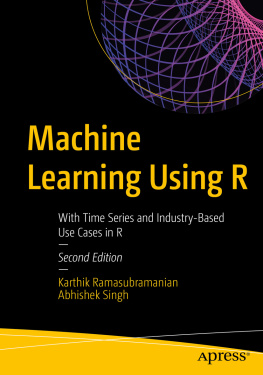List of Contributors
Wei Zhang
PhD up-and-comeR at the Institute of Software, Chinese Academy of Sciences (ISCAS), Beijing, P.R.CHINA, e-mail: zh3feng@gmail.com , has written chapters of Naive Bayes and SVM.
Fei Pan
MasteR at Beijing University of Technology, Beijing, P.R.CHINA, e-mail: example@gmail.com , has written chapters of KMeans, AdaBoost.
Yong Li
PhD competitoR at the Institute of Automation of the Chinese Academy of Sciences (CASIA), Beijing, P.R.CHINA, e-mail:
liyong3forever@gmail.com , has written chapters of Logistic Regression.
Jiankou Li
PhD applicant at the Institute of SoftwaRe, Chinese Academy of Sciences (ISCAS), Beijing, P.R.CHINA, e-mail: lijiankoucoco@163.com , has written chapters of BayesNet.
xi
Notation
Introduction
It is undeniably challenging to think of a solitary, reliable documentation to cover the wide assortment of information, models and calculations that we talk about. Besides, shows difer between AI and insights, and between various books and papers. All things considered, we have attempted to be pretty much as reliable as could be expected. Beneath we sum up a large portion of the documentation utilized in this book, albeit individual areas might present new documentation. Note likewise that a similar image might have various implications relying upon the specific situation, in spite of the fact that we attempt to stay away from this where possible.
General math notation
Symbol Meaning
x Floor of x, i.e., round down to closest integer
x C eiling of x, i.e., gather together to closest number x y Convolution ofx andy x y Hadamard (elementwise) item ofx andy a b consistent AND
a b legitimate OR
a coherent NOT
I(x) Indicator work, I(x) = 1 in case x is valid, else I(x) = 0 Infinity Tends towards, e.g., n
Proportional to, so y = hatchet can be composed as y x |x| Absolute value
|S| Size (cardinality) of a
set n! Factorial function
Vector of first derivatives
2 Hessian lattice of second derivatives
Defined as
O( ) Big-O: generally implies significant degree R The genuine numbers 1 : n Range (Matlab show): 1 : n = 1,2, ...,n Approximately equivalent to arg max f(x) Argmax: the worth x that expands f
x (a)(b)B(a,b) Beta capacity, B(a,b) =
(a+b)
(k)
B
(
)
Multivariate beta function,
k
(
) (
n
)
k
n pick k , equivalent to n!/(k!(nk)!)k(x) Dirac delta function,(x) = if x = 0, else (x) = 0 xexp(x) Exponential capacity e ux1eudu(x) Gamma work, (x) = 0 d log(x)(x) Digamma
function,Psi(x) =dx
xiii X A set from which esteems are drawn (e .g.,X =RD)
Linear algebra notation
We use boldface lower-case to indicate vectors, such asx, and boldface capitalized to mean grids, such asX. We indicate sections in a grid by nonstrong capitalized letters, for example, Xi j.
Vectors are thought to be segment vectors, except if noted in any case. We use (x1, ,xD) to indicate a segment vector made by stacking D scalars. Assuming we compose X = (x1, ,xn), where the left hand side is a grid, we intend to stack thexi along the sections, making a matrix.
Symbol Meaning
X 0 X is a positive unmistakable
lattice tr(X) Trace of a matrix
det(X) Determinant of matrixX
|X| Determinant of
matrixX X1 Inverse of a
matrix
X Pseudo-reverse of a
network XT Transpose of a
matrix
xT Transpose of a vector
diag(x) Diagonal framework produced using
vectorx diag(X) Diagonal vector extricated from
matrixX
I orId Identity grid of size dd (ones on corner to corner, zeros of) 1 or 1d Vector of ones (of length d)
0 or 0d Vector of zeros (of length d)
d x2||x|| =||x||2 Euclidean or 2 norm1 jj= d
||
x||1 1 standard xj
j
=
1
X:,j j th segment of matrix
Xi,: render of ith line of grid (a segment vector) Xi,j Element (I, j) of matrixX
x y Tensor item ofx andy
Probability notation
We signify arbitrary and fixed scalars by lower case, irregular and fixed vectors by strong lower case, and irregular and fixed lattices by intense upper case.
Occasionally we utilize non-striking capitalized to indicate scalar irregular factors. Likewise, we use p() for both discrete and ceaseless arbitrary variables
Symbol Meaning
X ,Y Random variable
P() Probability of an irregular event
F() Cumulative appropriation function(CDF), additionally called circulation work p(x) Probability mass function(PMF)
f(x) likelihood thickness function(PDF)
F(x,y) Joint
CDF p(x,y)
Joint PMF
f(x,y) Joint
PDF
Notation xv
p (X|Y) Conditional PMF, likewise called contingent likelihood fX|Y(x|y) Conditional PDF
X Y X is autonomous of Y X Y
X isnt autonomous of Y
XY|Z X is restrictively free of Y given Z
X Y|Z X isnt restrictively free of Y given Z X p X is
conveyed by dissemination p
Parameters of a Beta or Dirichlet dispersion
cov[X] Covariance of X
E[X] Expected worth of X
Eq[X] Expected worth of X wrt dispersion q
H(X) or H(p) Entropy of conveyance p(X)
I(X;Y) Mutual data among X and Y KL(p||q) KL
dissimilarity from appropriation p to q () Log
probability function
L(,a) Loss work for making a move a when genuine condition of nature is
Precision (reverse difference) =
1/2 Precision grid = 1
mode[X] Most plausible worth ofX
Mean of a scalar distribution
Mean of a multivariate distribution
cdf of standard normal
pdf of standard normal
multinomial boundary vector, Stationary circulation of Markov chain Correlation coefficient
sigm(
x
)
Sigmoid (calculated) work, 1
1 +ex
2 Variance
Covariance
framework var[x]
Variance of x
Degrees of opportunity parameter
Z Normalization steady of a likelihood distribution
Machine learning/statistics notation
In general, we use upper case letters to denote constants, such as C,K,M,N,T, etc. We use lower case letters as dummy indexes of the appropriate range, such as c = 1 : C to index classes, i = 1 : M to index data cases, j = 1 : N to index input features, k = 1 : K to index states or clusters, t = 1 : T to index time, etc.
We utilize x to address a noticed information vector. In a managed issue, we use y ory to address the ideal result name. We usez to address a secret variable. Once in a while we likewise use q to address a covered up discrete variable.
Symbol Meaning
C Number of classes
D Dimensionality of information vector (number of highlights) N Number of information cases Nc Number of instances of class c,Nc =N I(yi = c)i=1 R Number of results (reaction factors) D Training dataD ={(xi,yi)|i = 1 : N} Dtest Test
information
X Input
space Y
Output space
K Number of states or aspects of a variable (regularly inert) k(x,y) Kernel function
K Kernel matrix
H Hypothesis
space L Loss
work J() Cost
function
f(x) Decision function
P(y|x) Conditional probability
Strength of 2 or 1regularizer
(x) Basis work development of element vectorx
Basis work extension of plan matrixX
q() Approximate or proposition
circulation Q(,old) Auxiliary
capacity in EM
T Length of a grouping
T(D) Test measurement
for data
T Transition network of Markov
chain Parameter vector
(s) sth test of boundary vector
Estimate (normally MLE or MAP) of
MLE Maximum probability gauge of
MAP MAP gauge of
Estimate (typically back mean) of
w Vector of relapse loads (called in insights) b block (called in statistics) W Matrix of relapse weights
xi j Component (i.e., include) j of information case I ,for I = 1 : N, j = 1 : D xi Training case, I = 1 : N
X Design framework of size ND










